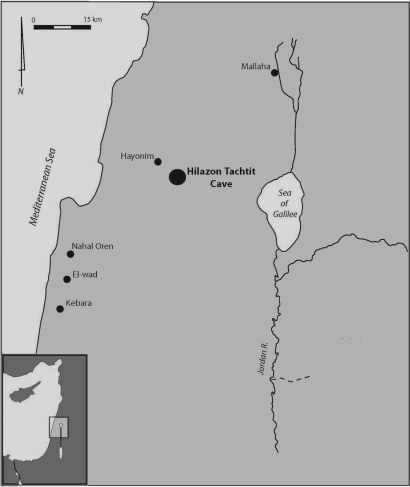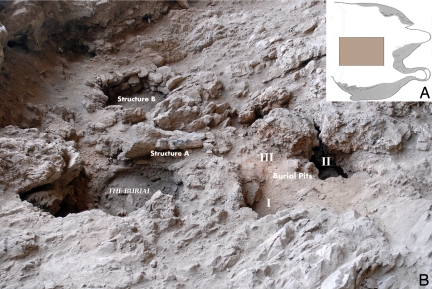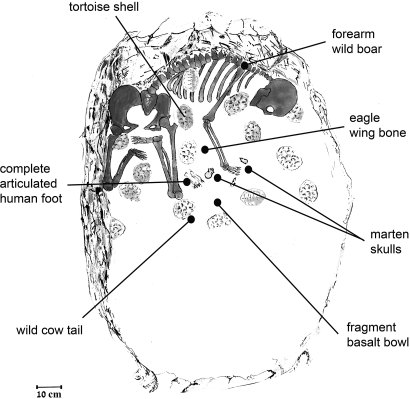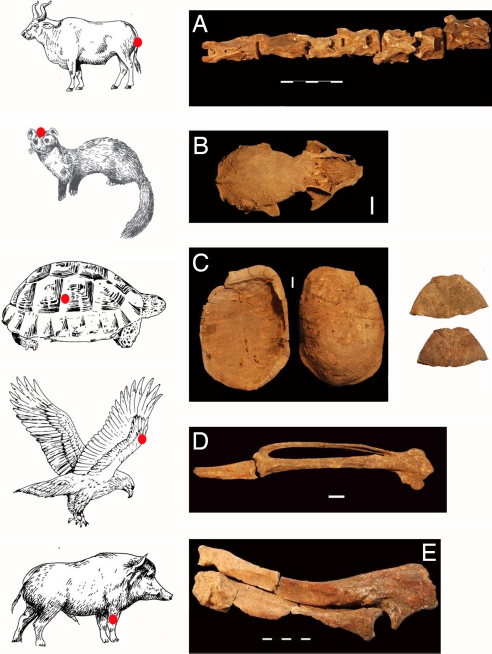Abstract
The Natufians of the southern Levant (15,000–11,500 cal BP) underwent pronounced socioeconomic changes associated with the onset of sedentism and the shift from a foraging to farming lifestyle. Excavations at the 12,000-year-old Natufian cave site, Hilazon Tachtit (Israel), have revealed a grave that provides a rare opportunity to investigate the ideological shifts that must have accompanied these socioeconomic changes. The grave was constructed and specifically arranged for a petite, elderly, and disabled woman, who was accompanied by exceptional grave offerings. The grave goods comprised 50 complete tortoise shells and select body-parts of a wild boar, an eagle, a cow, a leopard, and two martens, as well as a complete human foot. The interment rituals and the method used to construct and seal the grave suggest that this is the burial of a shaman, one of the earliest known from the archaeological record. Several attributes of this burial later become central in the spiritual arena of human cultures worldwide.
Keywords: Hilazon Tachtit Cave, Natufian, mortuary practices, origins of agriculture
The Natufian culture in the southern Levant (ca. 15,000–11,600 cal BP) is marked by significant changes in human burial practices (1, 2). More than 400 individuals have been recovered from organized Natufian cemeteries signifying a dramatic increase in the number of dead recovered in comparison to any preceding cultural period. This new burial practice is related to a dramatic socioeconomic change associated with the central role of the Natufian culture in the transition from foraging to farming. The Natufians were the first society to adopt a sedentary lifestyle (3–5) and thus, experienced substantial socioeconomic reorganization and innovation necessitated by the demand of aggregation for long periods of time. First and foremost amongst these changes is the beginning of the shift from a foraging to a farming economy (6). Sedentism undoubtedly created new demands regarding social behavior as well. Intensified social activity may, in part, explain the unprecedented fluorescence of symbolic activity observed in the Natufian (7). Nevertheless, to date there are nearly no indications of institutionalized social stratification (5, 8) and most researchers have assumed that the Natufians maintained an egalitarian social system, typical of most past and present hunting-gathering societies [but see (9) and discussion in (10)]. Still, to enable people to share their living space and daily life with nonkin group members for prolonged periods, there was a need to incorporate new social regulatory mechanisms into the belief system (11).
Tracing the development of past human belief systems is a demanding task as the archaeological record preserves only material aspects of the social and spiritual domains. Although burial practices do provide unequivocal data pertaining to prehistoric beliefs, they are rarely observed in Paleolithic periods. Recent excavations at the Natufian site of Hilazon Tachtit in the western Galilee region have revealed a unique burial of an elderly woman. The grave portrays several attributes that later become central in the spiritual arena of human cultures worldwide.
Results
The Archaeological Background.
Hilazon Tachtit is a small cave site in the Galilee region of Israel (Fig. 1) that functioned first and foremost as a Natufian burial ground for at least 28 individuals. Facing east, the cave is located on an escarpment ≈150 m above Nahal (river) Hilazon, 14 km from the Mediterranean shoreline. The site provides a wide view of the Mediterranean shore to the west and the upper Nahal Hilazon to the east. The single prehistoric Natufian occupation inside the cave is dated to 12,400–12,000 cal BP (RTT 3760, RTT4592, RTT 4593), within the later stage of the Natufian period (12).
Fig. 1.
The location of the site of Hilazon Tachtit Cave and other sites with cemeteries in the Natufian core area.
The prehistoric activity inside the cave was spatially confined to a shallow depression formed by the natural contours of the bedrock in the middle of the cave (= 30 m2). The excavations unearthed 2 small structures (ca. 1 m in diameter) built of undressed, limestone cobbles (Fig. 2). Both structures are circular and are delineated by large stones transported from outside the cave and positioned along the natural outline of the bedrock. Next to the structures are 3 small burial pits (Pit I, Pit II, and Pit III, ≈0.5 m2 each) that occupy an area of 5 m2 to a depth of 80 cm (Fig. 2). The pits contained the remains of at least 25 individuals representing an array of ages. In Pit III, some bodies had to be pushed aside to squeeze a number of individuals (n = 5) into the small space. Apart from the hands and feet, the skeletons were not articulated, although size and age estimates suggest that elements of single individuals were clustered together. Because many skeletal parts are missing from the pits, specifically long bones and skull elements, these collective graves likely served as primary burial areas that were later re-opened to remove skulls and long bones for secondary burial—a practice common to the Natufian and the following Neolithic cultures (13). Only 3 partially complete primary burials were recovered at Hilazon Tachtit. The first was located at the top of the Natufian sequence in the cave. This skeleton is of a young adult (sex unknown) reposed in a flexed position on its right side with both hands under its face. Unfortunately, many of the bones were missing, probably because of historical disturbance. The scattered bones of a newborn were found in the area of the missing pelvis and it appears that the newborn and the young adult, possibly the mother, were buried together. The 2 other complete burials belong to an earlier phase and are interred in graves within structures A and B (Fig. 2). The burial in structure B postdates the use of the structure, while the burial of the individual interred in Structure A, the topic of the present discussion, predates the use of Structure A. Thus, it appears that this particular burial is the earliest Natufian manifestation on site.
Fig. 2.
Plan and features of Hilazon Tachtit Cave. (A) Plan of the cave indicating the excavation area. (B) The Natufian features at Hilazon Tachtit Cave including the burial pits (pit I, II, and III), Structure A, and Structure B. The burial was located in structure A (Photograph by N. Hilger, Tel Aviv, Israel).
The Burial in Structure A.
The grave in structure A is located in an oval basin that was intentionally cut into sterile breccia situated beneath the Natufian levels. A large triangular limestone slab (40 cm × 75 cm) sealed the top of the grave. The walls of the oval basin show clear evidence of special treatment before burial. Fourier-Transform Infrared (FTIR) mineral analysis of sediment sampled from the grave walls indicates that the grave was intentionally plastered with mud collected immediately outside of the cave (the FTIR analysis was carried out by R. Shahack-Gross and L.G.). Small limestone slabs were pressed into the mud walls to create a strong foundation, and several large limestone slabs lined the floor.
At the time of burial, >10 large stones were placed directly on the head, pelvis, and arms of the buried individual (Fig. 3). Following decomposition of the body, the weight of the stones caused the disarticulation of some parts of the skeleton, including the separation of the pelvis from the vertebral column. The body was buried in an unusual position; it was laid on its side with its spinal column, pelvis, and right femur resting against the curved southern wall of the oval-shaped grave. The legs were spread apart and folded inward at the knee.
Fig. 3.
X-ray of the fragmented right and left pubis, body, and spine of a lumbar vertebra showing lipping and osteophytes (Photographs by M. Lavi, Institute of Archaeology, The Hebrew University, Jerusalem, Israel).
The human remains were analyzed by L.G. and A.B.-C., and indicate that the burial is of a gracile female, ≈45-years-old and estimated to be 1.5-m tall [based on long bone and skull measurements (14)]. Sex was determined primarily on the basis of the pelvis and femur [sciatic notch score 1 (15); curvature index 40, after (16); femur vertical diameter 39 mm; length <390 mm]. Several skeletal pathologies including vertebral lipping, osteophytes, and heavy erosion of the teeth are consistent with pathologies accrued during life, indicating that the woman was relatively old. In addition, congenital pathologies were observed including the fusion of the coccyx and the sacrum, and deformations of the pelvis and the lumbar and sacral vertebrae (Fig. 4). Pathologies of this nature would have affected the woman's gait (i.e., limping or foot dragging) and would have given her an unnatural, asymmetrical appearance. The woman was interred with a number of highly unusual grave goods. A fragment of a worn, basalt bowl (14-cm long) was recovered above her left leg, as was a complete articulated human foot (Fig. 3). The foot belonged to an adult individual who was substantially larger than the interred woman. A pointed bone tool was placed perpendicularly to the left tibia and a round pebble with two knapping scars (10-cm in diameter) was placed on the left side of the pelvis.
Fig. 4.
An artistic reconstruction of the Shaman grave. (Illustration by P. Groszman, Jerusalem, Israel, drawn to scale.)
Most remarkably, the female was buried with >50 complete tortoise shells (Mediterranean spur-thighed tortoise; Testudo graeca). The carapaces from >15 of these individuals were articulated when exposed during excavation (Fig. 5), but most of the shells had separated along their natural sutures as a result of decomposition. Although the carapaces were buried intact (disarticulated segments were rarely broken and segments from different parts of the shell were equally represented), the anterior plastron was repeatedly broken in the same location. The resulting spiral fracture crossed multiple segments and is consistent with human breakage by using a hammerstone while the shell was still fresh. Repeated breaks also occur along the lateral margins of the plastron where it meets the carapace, indicating that the plastron was removed from the carapace leaving the carapace intact. The plastron (Fig. 5) was likely broken to remove the tortoise from its shell, potentially for consumption as part of a feast surrounding the interment of the deceased. High representation of limb bones (from ≤30 individuals) indicates that most tortoise remains were thrown into the grave along with the shells after consumption or that the tortoises were placed in the grave inside their shells despite removal of the anterior plastron. The recovery of the limb bones also indicates that entire tortoises, not only their shells, were transported to the cave for the burial. The collection of at least 50 tortoises at the time of burial would have required a significant investment, as these are solitary animals. Alternatively, these animals could have been collected and confined by humans for a period preceding the burial event.
Fig. 5.
The animal body-parts present in the Shaman grave. The location of the body-part represented is indicated on the animal illustration with a red dot. (A) Caudal vertebrae from an auroch's tail (Bos primigenius); (B) complete marten (Martes foina) skull; (C) carapace of a spur-thighed Mediterranean tortoise (Testudo graeca) and examples of the anterior plastron which was repeatedly broken in the same location; (D) carpometacarpus and first phalanx of digit II from the wing tip of a golden eagle (Aquila chrysaetos); and (E) articulated forearm (radius and ulna) of a wild boar (Sus scrofa). (Photographs by G. Hartman, Department of Anthropology, Harvard University, Cambridge, MA; Illustrations by P. Groszman.)
The grave also contained body-parts of several animals that are unusual either because the taxa or body-parts rarely occur in Natufian assemblages, or because they were largely complete. Unbroken bones are extremely uncommon in Natufian sites, as the Natufians intensively processed bones to acquire essential fat sources (17). Two stone marten (Martes foina) skulls (Fig. 5), one complete and one anterior half, were interred in the grave. The complete skull was located directly above the third human foot. The absence of skinning marks typically found on the premaxilla of these fur-bearing animals, suggests that the crania were buried with their skins attached. A carpometacarpus and first phalanx of digit II constitute the wing tip of a golden eagle (Aquila chrysaetos) (Fig. 5). The wing tip supports the eagle's large and colorful primary feathers. Several articulated caudal vertebrae from the tail of an aurochs (Bos primigenius) represent the only aurochs body-part found in this grave. The near complete pelvis of a leopard (Panthera pardus), an extremely rare animal in Natufian contexts, was found between 2 articulated tortoise shells. The articulated forearm (radius and ulna) of a wild boar (Sus scrofa) was directly aligned with the woman's left humerus. Unlike all other ungulate long bones recovered from the site, the wild boar bones are complete, except for a long thin segment removed from the anterior shaft of the radius when the bone was still fresh. This break would have enabled the extraction of bone marrow although leaving the fused radio-ulna largely intact. Finally a complete, male gazelle horn core was found in direct association with the fragment of a basalt bowl and 3 Cerastoderma shells, directly under the human pelvis. Male gazelle horn cores have both functional and spiritual uses in Natufian contexts, and have appeared in other Natufian graves (18).
Discussion
The burial of the woman in Structure A at Hilazon Tachtit is unlike any burial found in the Natufian or the preceding Paleolithic periods. As the Natufian is a revolutionary cultural entity marked by new economic and social practices, it is not surprising that it is associated with new burial traditions. For example, the Natufians were the first people to routinely bury their dead close to or within their living sites. The burials occur both alone and in groups, and in many instances, human body-parts were removed either at the time of burial or after decomposition had set in (19). Some of the burials were accompanied by a variety of grave inclusions comprising ornaments, bone and stone tools and occasionally complete animals or their body-parts. Although these traditions are reflected in many Natufian graves, the combined characteristics of the grave in Structure A place it well outside of the norm of Natufian burials. Clearly, a great amount of time and energy was invested in the preparation, arrangement, and sealing of the grave. This was coupled with the special treatment of the buried body—the placement of stones directly on the woman to protect/keep the body in a desired position or to hold it in the grave. The unique grave goods accompanying the burial, in particular the many tortoises carefully arranged in relation to the body (under the skull, the pelvis, and at the perimeter of the grave) are substantially more numerous and diverse than those that have been recovered from other Natufian graves. Finally, the stratigraphy and construction sequence at the site suggest that the grave in Structure A represents the first use of the cave by the Natufians. The site is located 150-m up a steep escarpment, and at this point, the closest known Natufian domestic site, Hayonim Terrace, is 10-km away. Significant investment was required for the transportation of the body to Hilazon Tachtit for burial. All of these efforts were invested in the burial of an elderly disabled woman. Together the evidence suggests that this woman held a unique position in the community.
We argue that this burial is consistent with expectations for a shaman's grave. Although the term shaman derives specifically from the Tungus people of Siberia (20), shamanistic figures are well-known from hunter-gatherer and small-scale agricultural societies world-wide. The shaman's primary role is to mediate between the human and the spirit worlds (21, 22, 23). Shamans act as messengers, healers, and magicians, and serve both the community and its members. Although shaman graves are highly variable, and thus, there are no standard criteria to identify a shaman in the archaeological record, a number of generalizations about shamans can be surmised from cross-cultural research: (a) shamans are associated with spiritual, magical, and healing powers; (b) shamans engage the help of spirits in animal form; (c) shamans are keepers of specialized knowledge; (d) shamans are ascribed high status within their communities; and (e) the status of shamans is reflected in their special treatment at death—their burials often contain artifacts reflecting their role in life (i.e., remains of particular animals and contents of healing kits) (20, 24, 25).
Ethnographic records describe a variety of ways to bury a shaman (21), but because shamans are always considered privileged persons, who therefore enjoy a different kind of afterlife from other members of their group, unusual features of their graves mark their special status. This is clearly the case with the burial discussed here. The elaborate and invested grave at Hilazon Tachtit confirms the special status of the buried individual and her high standing within the community. Moreover, although pathologies are not universally characteristic of shamans, there are numerous cross-cultural accounts of physically disabled individuals being ascribed healing and spiritual powers (26, 27). The goods accompanying the burial are also typical of shaman burials. Tortoises, cow tails, eagle wings, and fur-bearing animals continue to play important symbolic and shamanistic roles in the spiritual arena of human cultures worldwide today [e.g., (28)]. It seems that the woman in the Natufian burial was perceived as being in a close relationship with these animal spirits.
Shamans are universally recorded cross-culturally, in hunter-gatherer groups and small-scale agricultural societies (25). Nevertheless, they have rarely been documented in the archaeological record [but see (29)], and none have been reported from the Paleolithic of Southwest Asia. Perhaps, it is not surprising if clear evidence for a shaman comes from the Natufian, as the profound social and economic changes associated with the transition to agriculture [the Neolithization process (6)] surfaced during the Natufian and undoubtedly entailed equally substantial ideological changes (30, 31, 32). Whether the changes in the spiritual outlook preceded and triggered the economic changes (33) or vice versa, an inseparable interplay is clearly observed between ideological and socioeconomic change across the forager-to-farmer transition. The unique grave at Hilazon Tachtit Cave provides us with rare concrete evidence for those processes in their initial stages at the termination of the Paleolithic on the eve of the Neolithic transformation.
Acknowledgments.
The authors are grateful to Baruch Arensburg, Uzy Smilansky, and Ofer Bar-Yosef for their help. Special thanks are due to R. Shahack-Gross for the FTIR analysis. We thank Naama Goren-Inbar and Erella Hovers for critically reading the manuscript, and Peter Groszman for the illustrations. We also thank Talia Goldman for her assistance with the graphics and Brian Hayden and two anonymous reviewers for their thoughtful remarks. Excavation was financed by the Irene Levi-Sala Care Foundation and the National Geographic Foundation (to L.G.). Research was supported by the Israel Science Foundation (202/05 to A.B.-C.) and National Science Foundation (BCS-0618937 to N.D.M.).
Footnotes
The authors declare no conflict of interest.
This article is a PNAS Direct Submission.
References
- 1.Bar-Yosef O. Natufian: A complex society of foragers. In: Fitzhugh B, Habu J, editors. Beyond Foraging and Collecting. New York: Plenum Publishers; 2002. pp. 91–149. [Google Scholar]
- 2.Bocquentin F. PhD dissertation. France: Université Bordeaux 1, 33405 Talence cedex; 2003. Pratiques funeraires, parameters biologiques et identities culturelles au Natoufien: Une analyse archeo-anthropologique. [Google Scholar]
- 3.Tchernov E. Biological evidence for human sedentism in southwest Asia during the Natufian. In: Bar-Yosef O, Valla FR, editors. The Natufian Culture in the Levant. Ann Arbor, MI: International Monographs in Prehistory; 1991. pp. 315–340. [Google Scholar]
- 4.Boyd B. On “sedentism” in the later Epipalaeolithic (Natufian) Levant. World Archaeol. 2006;38:164–168. [Google Scholar]
- 5.Belfer-Cohen A, Bar-Yosef O. Early sedentism in the near east: A bumpy ride to village life. In: Kuijt I, editor. Life in Neolithic Farming Communities. Social Organization, Identity, and Differentiation. New York: Kluwer Academic/Plenum; 2000. pp. 19–38. [Google Scholar]
- 6.Bar-Yosef O, Valla F. The Natufian culture and the origin of the Neolithic in the Levant. Curr Anthropol. 1990;31:433–436. [Google Scholar]
- 7.Belfer-Cohen A. The Natufian in the Levant. Ann Rev Anthropol. 1991;20:167–186. [Google Scholar]
- 8.Kuijt I. Place, death, and the transmission of social memory in early agricultural communities of the near eastern pre-pottery Neolithic. In: Chesson MS, editor. Social Memory, Identity, and Death: Anthropological Perspectives on Mortuary Rituals. Washington D.C: Archeological Papers of the American Anthropological Association 10; 2001. pp. 80–99. [Google Scholar]
- 9.Henry DO. From Foraging to Agriculture: The Levant at the End of the Ice Age. Philadelphia: University of Pennsylvania Press; 1989. [Google Scholar]
- 10.Hayden B. Sociopolitical organization in the Natufian: A view from the northwest. In: Delage C, editor. The Last Hunter-Gatherer Societies in the Near East. Oxford: BAR International Series; 2004. pp. 263–308. [Google Scholar]
- 11.Kosse K. The evolution of large, complex groups: A hypothesis. J Anthropol Archaeol. 1994;13:35–50. [Google Scholar]
- 12.Grosman L. Preserving cultural traditions in a period of instability: The late Natufian of the hilly Mediterranean zone. Curr Anthropol. 2003;4:571–580. [Google Scholar]
- 13.Byrd B, Monahan CM. Death, mortuary ritual, and Natufian social structure. J Anthropol Archaeol. 1995;14:251–287. [Google Scholar]
- 14.Duyar I, Pelin C. Body height estimation based on tibia length in different stature groups. Am J Phys Anthropol. 2003;122:23–27. doi: 10.1002/ajpa.10257. [DOI] [PubMed] [Google Scholar]
- 15.Walker PL. Greater sciatic notch morphology: Sex, age, and population differences. Am J Phys Anthropol. 2005;127:385–391. doi: 10.1002/ajpa.10422. [DOI] [PubMed] [Google Scholar]
- 16.Takahashi H. Curvature of the greater sciatic notch in sexing the human pelvis. Anthropol Sci. 2006;114:187–191. [Google Scholar]
- 17.Munro N, Bar-Oz G. Gazelle bone fat processing in the Levantine Epipalaeolithic. J Archaeol Sci. 2005;32:223–239. [Google Scholar]
- 18.Tchernov E, Valla FR. Two new dogs, and other Natufian dogs, from the southern Levant. J Archaeol Sci. 1997;24:65–95. [Google Scholar]
- 19.Belfer-Cohen A. Rethinking social stratification in the Natufian Culture: The evidence from burials. In: Campbell S, Green A, editors. The Archaeology of Death in the Ancient Near East. Edinburgh: Oxbow Monographs; 1995. pp. 9–16. [Google Scholar]
- 20.Balzer MM. Flights of the sacred: Symbolism and theory in Siberian Shamanism. Am Anthropol. 1996;98:305–318. [Google Scholar]
- 21.Eliade M. In: Shamanism; Archaic Techniques of Ecstasy. Trask WR, translator. London: Arkana Penguin Books; 1988. [Google Scholar]
- 22.Nicholson S. Shamanism: An Expanded View of Reality. Wheaton, IL: Theosophical Publishing House; 1987. [Google Scholar]
- 23.Hayden B. Shamans, Sorcerers, and Saints. Washington, DC: Smithsonian Books; 2003. [Google Scholar]
- 24.Jakobsen MD. Shamanism: Traditional and Contemporary Approaches to the Mastery of Spirits. New York: Berghahn Books; 1999. [Google Scholar]
- 25.Winkelman MJ. Shamans and other “Magico-Religious” healers: A cross-cultural study of their origins, nature, and social transformations. Ethos. 1990;18:308–352. [Google Scholar]
- 26.Formicola V, Buzhilova AP. Double child burial from Sunghir (Russia): Pathology and inferences for upper Paleolithic funerary practices. Am J Phys Anthropol. 2004;124:189–198. doi: 10.1002/ajpa.10273. [DOI] [PubMed] [Google Scholar]
- 27.Formicola V, Pontradolfi A, Svoboda J. The Upper Paleolithic triple burial of Dolní Věstonice: Pathology and funerary behavior. Am J Phys Anthropol. 2001;115:372–379. doi: 10.1002/ajpa.1093. [DOI] [PubMed] [Google Scholar]
- 28.Merkur D. Eagle, the hunter's helper: The cultic significance of Inuit mythological tales. Hist Religions. 1987;27:171–188. [Google Scholar]
- 29.Porr M, Alt KW. The burial of Bad Dürrenberg, central Germany: Osteopathology and osteoarchaeology of a Late Mesolithic shaman's grave. J Osteoarchaeol. 2006;16:395–406. [Google Scholar]
- 30.Hershman D. PhD dissertation. Jerusalem: The Hebrew University; 2005. The rise of religion in the southern Levant. [Google Scholar]
- 31.Grosman L, Belfer-Cohen A. Zooming onto the “Younger Dryas”. In: Cappers RTJ, Bottema S, editors. The Dawn of Farming. Berlin: ex oriente; 2002. pp. 49–54. [Google Scholar]
- 32.Grosman L, Munro N. The sacred and the mundane: Domestic activities at a Late Natufian burial site in the Levant. Before Farming. 2007;2007(4):4. [Google Scholar]
- 33.Cauvin J. The Birth of the Gods and the Origins of Agriculture. Cambridge: Cambridge Univ Press; 2000. [Google Scholar]







